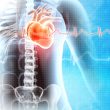We are still asking the same question: ticagrelor or prasugrel? With narrow margins between these drugs in terms of efficacy and bleeding, it is difficult to decide which to prescribe. While it has certain methodological limitations, this research published in JAMA seems to clarify the picture at least for patients with acute coronary syndromes who<a href="https://solaci.org/en/2021/07/16/ticagrelor-or-prasugrel-for-acute-patients-who-undergo-angioplasty/" title="Read more" >...</a>
FLOWER-MI: FFR vs. Angiography for Complete Revascularization in Infarction
Functional assessment with fractional flow reserve (FFR) was not better than conventional angiography to guide complete revascularization in patients with multivessel lesions in a setting of ST-segment elevation myocardial infarction and successful primary angioplasty. These results were published in the New England Journal of Medicine (NEJM) and presented during the American College of Cardiology (ACC)<a href="https://solaci.org/en/2021/06/07/flower-mi-ffr-vs-angiography-for-complete-revascularization-in-infarction/" title="Read more" >...</a>
ACC 2021 | Emergent CABG for acute MI: Benefits Despite Risk
The latest figures show a lower number of emergency CABG for acute MI, and in turn increased primary PCI. The combination of surgeons not willing to take risks and interventional cardiologists empowered to treat practically any lesion has resulted in fewer patients receiving emergency CABG. Only a few years ago, interventional cardiologists at least had<a href="https://solaci.org/en/2021/05/18/acc-2021-emergent-cabg-for-acute-mi-benefits-despite-risk/" title="Read more" >...</a>
The Ten Commandments from the New Guidelines on Infarction Without ST-Segment Elevation
In 2020, the European Society of Cardiology guidelines for the management of patients with acute coronary syndromes without ST-segment elevation (Non-ST-Segment Elevation Myocardial Infarction, NSTEMI) were presented. This document went somewhat unnoticed in the context of the COVID-19 pandemic, so this seems a good time to review it and set out some practical “commandments” (something<a href="https://solaci.org/en/2020/11/05/the-ten-commandments-from-the-new-guidelines-on-infarction-without-st-segment-elevation/" title="Read more" >...</a>
Infarction, Stroke and Aortic Emergency Syndromes in the Shadow of the Pandemic
The coronavirus pandemic has had a negative impact on the most pressing cardio and neurological emergencies, such as strokes or aortic dissection. These emergencies are normally treated in high complexity centers, which is why it is relatively simple to analyze the number of transfers before and after the pandemic. For some time, care centers have<a href="https://solaci.org/en/2020/08/11/infarction-stroke-and-aortic-emergency-syndromes-in-the-shadow-of-the-pandemic/" title="Read more" >...</a>
Temporary Emergency Guidelines for Infarction During the Pandemic
Several United States societies (the American Heart Association [AHA] among them) have answered the question of many physicians in the front lines: what is the ideal strategy for the treatment of ST segment elevation myocardial infarction (STEMI) during the COVID-19 pandemic? This document intends to ensure that patients with STEMI continue to receive adequate, proven<a href="https://solaci.org/en/2020/06/03/temporary-emergency-guidelines-for-infarction-during-the-pandemic/" title="Read more" >...</a>
Management of Infarction During the COVID-19 Pandemic
Patients with cardiovascular disease infected with COVID-19 are at a particular risk for morbidity and mortality. In any case, it should be noted that most patients requiring cardiovascular care due to ischemic heart disease, peripheral vascular disease, or structural heart disease are not infected. Being prepared to face this pandemic is as important as guaranteeing<a href="https://solaci.org/en/2020/05/14/management-of-infarction-during-the-covid-19-pandemic/" title="Read more" >...</a>
Virtual ACC 2020 | Colchicine After Infarction: Good Results and Cost-Effectiveness
Low doses of colchicine reduce the risk of ischemic events after an acute myocardial infarction, according to the COLCOT trial, originally presented at the American Heart Association (AHA) 2019 Scientific Session and simultaneously published in the New England Journal of Medicine (NEJM). The new information featured at the virtual ACC 2020 refers to its cost-effectiveness. Colchicine<a href="https://solaci.org/en/2020/04/01/virtual-acc-2020-colchicine-after-infarction-good-results-and-cost-effectiveness/" title="Read more" >...</a>
Virtual ACC 2020 | Myocardial Ischemia Induced by Sudden Mental Stress
Myocardial ischemia induced by sudden mental stress is associated with bad prognosis, especially in patients with a history of acute myocardial infarction according to this new study. This study, called MIMS-2, was meant to be presented at ACC 2020 together with the World Congress of Cardiology in Chicago, which was shut down because of the<a href="https://solaci.org/en/2020/03/25/virtual-acc-2020-myocardial-ischemia-induced-by-sudden-mental-stress/" title="Read more" >...</a>
Mechanisms of Infarction in Coronary Arteries with Non-Significant Lesions
Infarctions with non-obstructive coronary artery disease, also known as MINOCA (myocardial infarction with nonobstructive coronary arteries), often present plaque rupture and thrombi associated with the affected myocardial territory. In these patients, optical coherence tomography (OCT) is of great value to identify the “culprit”. Even though atherosclerosis has been identified as a potential MINOCA mechanism, the<a href="https://solaci.org/en/2020/01/02/mechanisms-of-infarction-in-coronary-arteries-with-non-significant-lesions/" title="Read more" >...</a>








